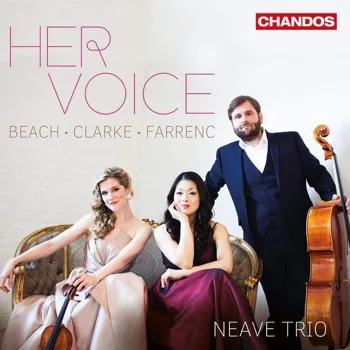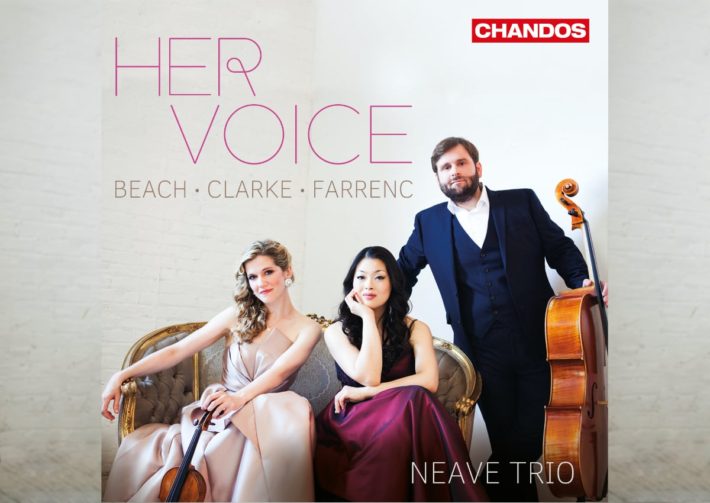Formed in 2010, the Neave Trio has championed the work of lesser-known composers. In a new Chandos release, the ensemble presents the piano trios of Louise Ferrenc, Amy Beach, and Rebecca Clarke. The album is mapped out to provide a historical trajectory through the voice of these female composers. Each trio is of a distinct idiom and character, and this, in turn, highlights the trio’s multifaceted and well-versed musical language.

Louise Ferrenc (1804-1875), a pianist, was born in France and studied with Moscheles and Hummel. Her Op. 33 Piano Trio is classical in style. The ensemble shows good attention to the idiom in which she writes. Throughout the piece, there is solid ensemble coordination, a light bowing technique that speaks to the elegance of the writing, and phrasing that is very much in tune with the early Beethoven/Haydnesque nature of the composition. Although Ferrenc generally follows traditional form in terms of harmonic progressions, there are moments of interesting key areas, which the ensemble does a lovely job of capturing, possessing harmonic sensitivity that manifests with changes in both dynamics and sound quality (listen to the sudden change in key at 0’40” in the first movement as an example). There are some moments in this first movement, however, that the playing is perhaps a little too elegant and restrained. In the first subject exposition, for instance, the piano line could be shaped with more emphasis on the peak of the phrase.
The Amy Beach Piano Trio, Op. 150 fast forwards to the late Romantic, early modernist era with its highly emotive writing and elements of harmonic experimentation. Beach (1867-1944) was an American composer, pianist, and chamber musician. She broke gender boundaries in her lifetime, becoming the first American woman to publish a symphony. The Neave trio’s interpretation of the trio is nicely done overall and conveys the delicacy of Beach’s writing. Of note is the first movement opening, which features a dialogue between piano and cello. The piano accompaniment is beautiful and fluid (one can imagine flowing water) and the cello line sings with warmth.
The piano harmonies are quite interesting here, and if anything, it would have been nice to hear them just a little more in the context of the cello. Beach writes with large-scale contours which are nicely recognized and structured by the trio. For example, the ensemble plays with purposeful control and restraint at the beginning of the first movement (perhaps a little too much at times), but this is what ultimately makes the violin line at 1’32″ really shine through. Well-timed and executed vibratos in the violin make its line sound lifelike. One thing that could be a bit better throughout the piece, however, is more contrast of character. Beach’s musical language is delicate but has moments of changes that are essential to the trajectory of the overall piece. An example lies in the second movement, whose middle section could use a more pronounced scherzando quality that contrasts with the lyricism of the rest of the movement. The third movement is also a little too tame and thus too consistent with previous movements. The Monte Trio’s interpretation (Genuin Classics, 2017), for instance, has just the right amount of electrifying “bite” needed in the third movement, mainly through shorter and stronger bowing.
The Neave trio gives the strongest and most electrifying performance with its interpretation of the Rebecca Clarke Trio. Clarke (1886-1979) was an English composer and violist who chose to focus on smaller-form works such as choral music, songs, and chamber music. Her work uses highly experimental, Debussian harmonies in an Expressionist idiom. Where the Ferrenc and Beach trios are graceful, the Clarke trio is dramatic, foreboding, and brooding. The group depicts the juxtaposition of drama and contemplativeness wonderfully. An example is the strong opening which immediately commands the listener’s attention, but that is contrasted with sensitivity in the D major section (6’20”).
The second movement opens with a violin line that is almost like a recitative; while the group’s interpretation is indeed thoughtful, it does border on being a little too static. The Gryphon Trio (Analekta, 2018) presents a line that sings a bit more. However, the communication and coordination between the cello and violin is well done, as heard at 1’57″. Interesting harmonies and folk, Bartok-like influences characterize the third movement. While the group’s tempo is a little slower than other recordings (such as in the Gryphon’s), it has a good rhythmic lilt. It is in this trio where the piano really shines, serving as a momentous driving force and giving the piece a three-dimensional quality with its round and encompassing sound. There is an effective use of bass harmonies that consistently support but do not overpower the strings.
If there are any hindrances to the ensemble’s solid performance, it is the sound engineering. While it shows the subtleties of the strings, the string-piano balance is off. The piano often sounds subdued and relegated to the far end of the room. This is a shame as the piano is so essential in each trio, having a lot of interesting musical commentary to offer.
“Her Voice”
Louise Farrenc – Trio No. 1, Op. 33
Amy Marcy Cheney Beach – Trio, Op. 150
Rebecca Clarke – Trio
Neave Trio
Anna Williams – Violin
Mikhail Veselov – Cello
Eri Nakamura – Piano
Chandos, CD 20139




















